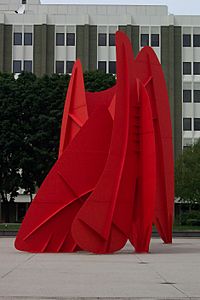La Grande Vitesse facts for kids
Quick facts for kids La Grande Vitesse |
|
|---|---|
 |
|
| Artist | Alexander Calder |
| Year | 1969 |
| Type | Painted steel |
| Dimensions | 13 m × 9.1 m × 16 m (43 ft × 30 ft × 54 ft) |
| Location | Vandenberg Plaza, Grand Rapids, Michigan |
La Grande Vitesse is a huge public sculpture by American artist Alexander Calder. It stands in the main plaza outside City Hall in Grand Rapids, Michigan. People often just call it "the Calder."
Since it was put up in 1969, this sculpture has become a famous symbol of Grand Rapids. You can even see a simplified version of it in the city's official logo!
Contents
About the Sculpture
La Grande Vitesse means "the great swiftness" in French. This can also be translated as "grand rapids," which is a clever nod to the city's name.
This sculpture was the very first public artwork paid for by the National Endowment for the Arts (NEA). The NEA is a special program that helps fund art projects across the United States.
Size and Look
The sculpture was built in Tours, France. Then, it was shipped in many pieces to Grand Rapids and put together right there in the plaza. It is truly enormous!
It stands 43 feet (about 13 meters) tall. It is also 54 feet (about 16 meters) long and 30 feet (about 9 meters) wide. This giant artwork weighs 42 tons, which is like weighing 10 large elephants!
La Grande Vitesse is painted in a bright, bold red color. This red is a special color that artist Alexander Calder often used in his artworks.
Calder's Stabiles
Alexander Calder created many large sculptures like La Grande Vitesse. He called these big, fixed sculptures "stabiles." This was to show they were different from his "mobiles." Mobiles are sculptures that move and balance in the air.
History of the Sculpture
A group of local leaders and art experts chose Alexander Calder for this important project in 1967. When people in Grand Rapids learned about his design, some were not sure about it.
Public Opinion
Some people wrote letters or made cartoons to show they didn't like the sculpture. But many others, including the mayor, spoke out to support Calder's artwork. They explained how important and special it would be for the city.
La Grande Vitesse was officially opened on June 14, 1969. Since then, it has become a much-loved symbol for the city.
Building the Sculpture
Calder made a smaller, 8-foot model of the sculpture in 1968. This model helped him plan the full-sized artwork. The actual sculpture was built in 27 large pieces.
These pieces were packed into wooden crates and shipped to Grand Rapids. It took five days to put the sculpture together in the plaza. People watched as welders worked and sparks flew. Then, the bright red paint was added. It was like watching a live show!
The cost of the sculpture was shared by the NEA, local groups, businesses, and many people in the community.
Small Model for Everyone
Near the base of La Grande Vitesse, there is a smaller model of the sculpture. It is about 1/23 the size of the real one. This model was made in 1976 with Calder's approval.
It was given to the city so that visitors who are blind could "see" the sculpture by touching this smaller version.
Where It Stands
The sculpture is located in a public area called the Civic Center. This area was designed by a famous architecture company. The Civic Center has two large buildings for City Hall and Kent County. These buildings are surrounded by a big concrete plaza.
The plaza where La Grande Vitesse stands is officially named Vandenberg Plaza. It is named after Senator Arthur H. Vandenberg. However, most people in Grand Rapids simply call it Calder Plaza.
Images for kids
-
Alexander Calder's La Grande Vitesse


